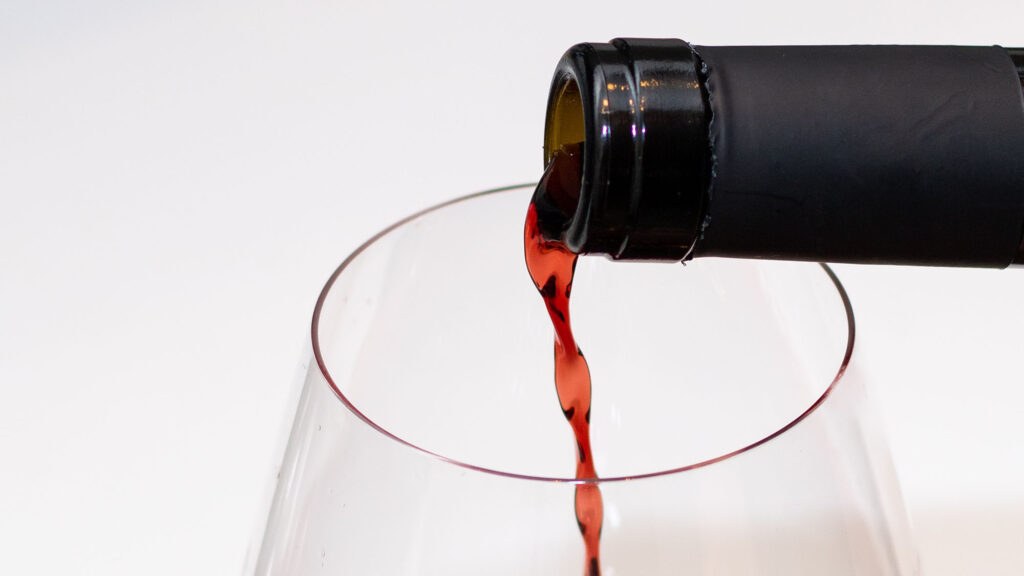Let’s say you’ve been selected to host the family Thanksgiving dinner this year. It is your opportunity to show off and win some respect from your elders. On Thursday, your carefully selected meal is prepped and ready to go. As you nestle the last guest in front of their name place card, panic creeps in. The wine expert at the local shop guided you to the perfect red wine pairing to match your meal and told you to let the wine breathe in a decanter for 30 minutes. With all the holiday commotion you completely forget to buy a decanter! Is there a way to let the wine breathe without a decanter?
The quick answer is yes, there are several ways you can let the wine breathe without a decanter. Common kitchen items such as a pitcher, a blender, or a large bowl are cheap and often faster ways to let the wine breathe without a decanter. Pour the bottle out into one of the above items, wait 30 minutes, and pour it back into the bottle/glasses.
Keep in mind that wine is all about personal preference. Try not to get hung up on the “rules of wine.” Be open to trying different methods to bring out the wine characteristics that you prefer.
Let’s go into more detail on why you should let your wine breathe as well as some other options for decanting without a decanter.
Why Should You Let Wine Breathe?

Before we explain some methods to let the wine breathe without a decanter let’s talk about why you should even do it in the first place.
Author Note: Letting a wine breathe is just that — allowing it to come in contact with oxygen. This causes evaporation and oxidation of volatile compounds. These chemical reactions are beneficial to wine in small amounts.
Unpleasant odors like rotten eggs, wet dog, or rubbing alcohol will dissipate bringing out the wine’s complex fruity floral aromas that make wine so much fun. Although exposed to air for too long your wine will become flat, turn brownish and eventually turn to vinegar. Simply adding a modest amount of oxygen will have your guests raising their glasses to you!
Winemakers take steps to allow the wine to maintain its intended flavor profile when bottled. Over time, as the wine ages in the bottle, it can develop aromas, reduce acidity, and soften tannins bringing a balanced smooth libation to your glass.
Yet, most of us don’t drink wine over eight years old on a regular basis. It can be very expensive and confusing. However, by letting a young wine breathe you can achieve a similar result in minutes rather than years.
The traditional way to introduce wine to oxygen is by using a decanter. The wine industry has introduced other devices throughout the years, but there are items you likely have on hand that will do the same thing.
What is All the Fuss About Decanters?
People have used decanters for wine since Roman times. Decanters are used to separate out sediment and allow the wine to breathe. Have you ever poured the last glass of a bottle of wine to find a gritty mixture that has taken over?
That’s sediment. It’s a natural by-product of wine-making made up of insoluble particles of grape skin, pulp, seeds, and sometimes stems. It will not harm you but may make for an unpleasant experience.
Luckily most wines made today have gone through extensive filtering processes to remove sediment. So that leaves you with the only chore of making sure your wine is exposed to oxygen.
Despite what many think, letting a bottle of wine sit open on the counter will not change a wine very much. The shape and narrow opening of the bottle is made to protect the wine from the air. Winemakers take steps to ensure wine is stable and will not undergo changes before it reaches your table.
A decanter exposes your wine to oxygen therefore reducing astringent characteristics. This occurs when you pour the wine and while it rests in the decanter. Decanters tend to have a wide bulb shape base that increases the surface area of wine exposed to air. The more surface area the faster harsh flavors will evaporate and oxidate out of your wine.
To use a decanter properly you should allow the wine to hit the side of the glass as you pour it in. Wait around 30 minutes and Voila! Goodbye, volatile compounds. Hello, enjoyable flavor profile!
A common alternative to using a decanter is a wine aerator. This is a small handheld tool that infuses pressurized oxygen as wine is poured through it. You instantly have flavorful silky wine ready to drink.
How Do You Know if You Need to Let a Wine Breath
While it’s ok to drink wine right out of the bottle your wine will typically taste better and be easier to drink if you let it breathe. A rule of thumb is to aerate young (less than eight years old) full-bodied red wines like cabernet sauvignon, Chianti, and Syrah.
Most red wines will benefit from air contact because they tend to have higher alcohol and tannin (what gives a wine that astringent drying texture in your mouth).
That said, not all wine will improve with air exposure. Some wines will lose their delicate bouquet and you will end up with dull grape juice. The majority of white wines, or any wine low in tannin for that matter, will get worse if you add oxygen to it. There are a few rare exceptions like a heavy White Burgundian.
Author Note: You should also take caution when you’re drinking light fragile red wines like Pinot Noir or Cotes Du Rhone. Taste the wine after you open it. If you like it how it is, drink up. If you find it “tight” or abrasive then it needs to be introduced to oxygen.
Now that you have an understanding of why, how, and which wines you should let breathe let’s solve that issue of not having a decanter.
How to Let Wine Breathe with a Pitcher:

Most people have a pitcher lying around. Depending on the shape and size this will basically mimic a decanter. Below are a few methods to use a pitcher to let wine breathe without a decanter.
Pitcher
- Any pitcher will do, but one that has a wide base is best. This will allow more wine surface area to touch air.
- After opening the wine bottle, tilt the pitcher as you pour so that the wine hits the inside wall of the pitcher.
- Let it sit for around 30 minutes.
Pitcher and a Whisk
- After opening the wine bottle, tilt the pitcher as you pour so that the wine hits the inside wall of the pitcher.
- Use a small stainless steel whisk to stir the wine.
- Once you start to see tiny bubbles start to form give it a taste. If the wine still tastes harsh mix a little longer or let the wine sit in the pitcher for a few minutes.
Two Pitchers
- After opening the wine bottle, tilt one pitcher and pour so that the wine hits the inside wall. Be sure not to fill it too full. It’s best to use light pitchers that are easy to handle.
- Pour the wine back and forth from one pitcher to the other.
- Continue this around15 times.
Tips
- You can always use a bowl in a pinch and a funnel to pour it neatly into your glasses.
- Always be sure to keep any wine away from heat like the stovetop or direct light. This will have unwanted effects on your wine.
How to Let Wine Breathe with a Blender
Blenders are not just for margaritas anymore! This is an incredibly fast solution. Be very careful with this method as it can quickly reduce the good characteristics of wine if it is too rigorous. If you don’t have a blender a food processor with a blade can be used.
- After opening the wine bottle, plug in your blender, and pour in the wine. And if you don’t have a wine opener, you can also open wine with a screwdriver.
- Turn the blender on the lowest speed for 15 seconds. The blade will slice air into your wine softening tannins. If you feel the blender getting warm, pulse it on and off instead. You do not want it to heat the wine.
How to Let Wine Breathe with a Water Bottle
Author Note: You might be wondering why in the world we would want you to drink wine out of a water bottle. We don’t. This is to circulate air into your wine. When you are finished you can pour it back into the bottle with a funnel or directly into your glasses.
Water Bottle

- You can use a sports bottle or a thoroughly cleaned disposable bottle. You need it to be round without a top that sticks out to the side.
- Pour some of your wine into the bottle so that it is no more than two-thirds full. There needs to be enough air left in the bottle to circulate through the wine. You can repeat the process later for any additional wine.
- Close the bottle tightly.
- Smoothly roll the bottle on its side back and forth across the counter. You can place a thin towel underneath if needed.
- Roll the bottle for around three minutes. If the wine still tastes too astringent you can continue a few more times.
Protein Shaker Bottle
- If you happen to have a protein shaker lying around, this will do the trick as well.
- Pour the wine filling the protein shaker two-thirds full.
- If your shaker came with a wire blender ball go ahead and throw that in. Tighten the top on.
- Shake the bottle quickly for two minutes.
- Test the wine. If it happens to still taste harsh shake it another minute more.
Time for a Toast
Being able to think on your feet when you’re hosting or enjoying a last-minute glass of wine is easy if you are armed with the right knowledge.
When you find yourself asking how can you let your wine breathe without a decanter remember the purpose of doing it in the first place. Young red wines need to come into contact with air to release volatile molecules and bring out the best flavors in your wine. Grab a few tools from your kitchen like a pitcher, a blender, or a water bottle and add a little oxygen to it.
As we mentioned at the beginning, wine is all about what you prefer. Don’t be afraid to experiment to find your perfect glass of wine. Have fun and enjoy it. Cheers!
To living a full-bodied life,
Wesley

